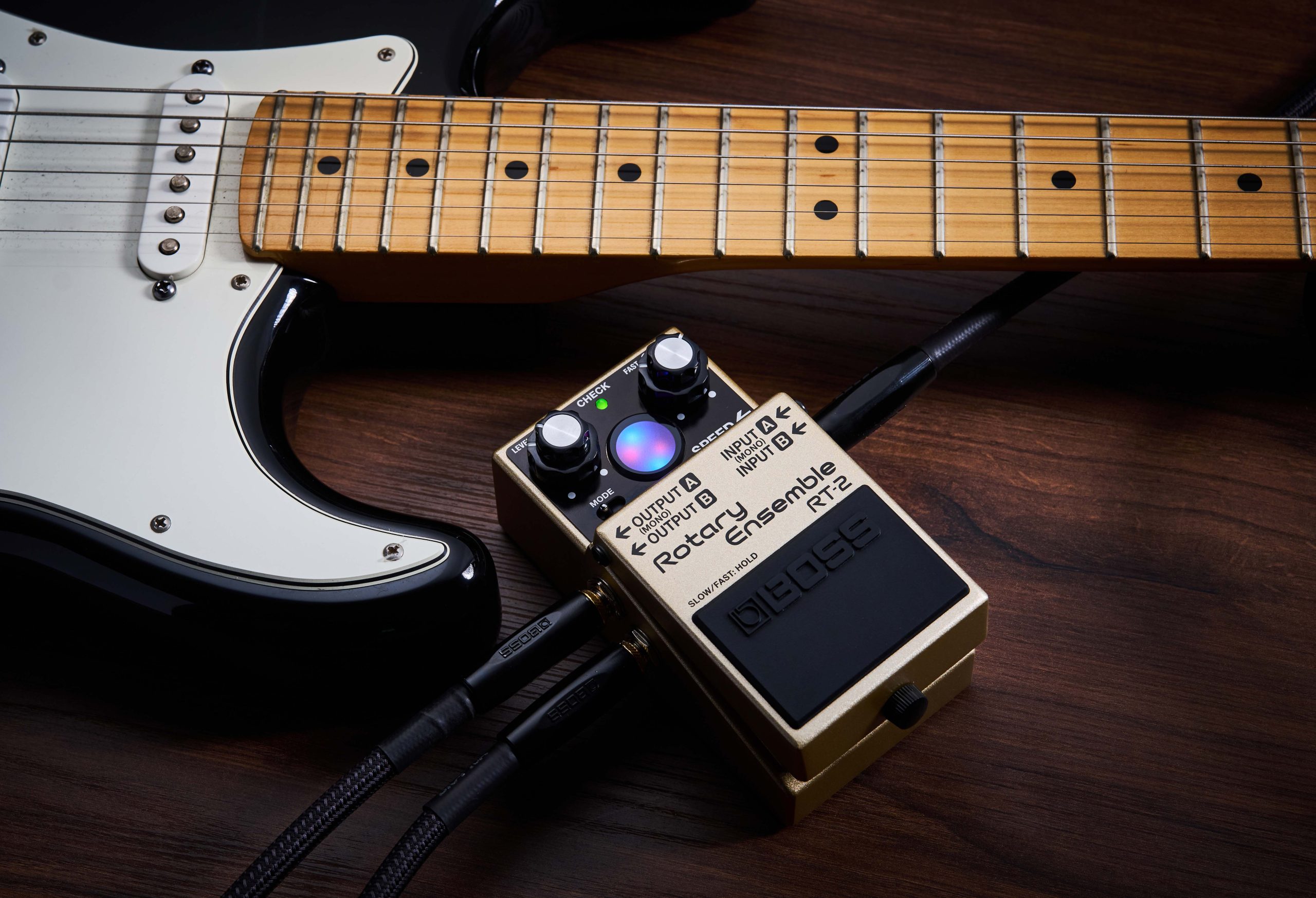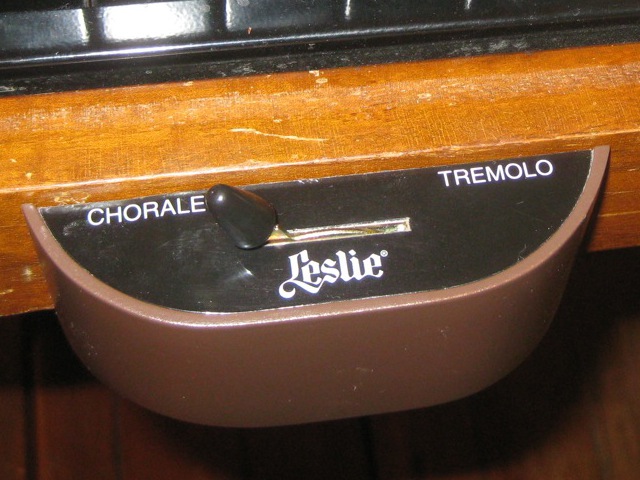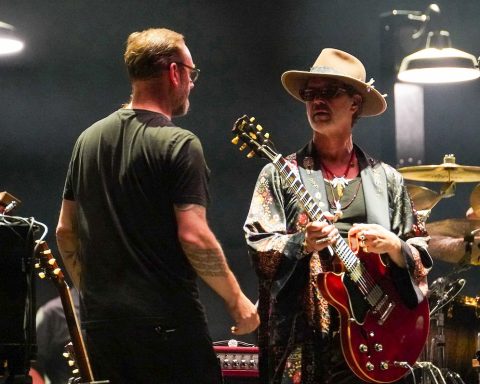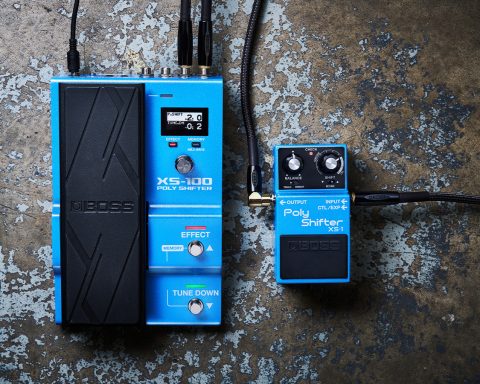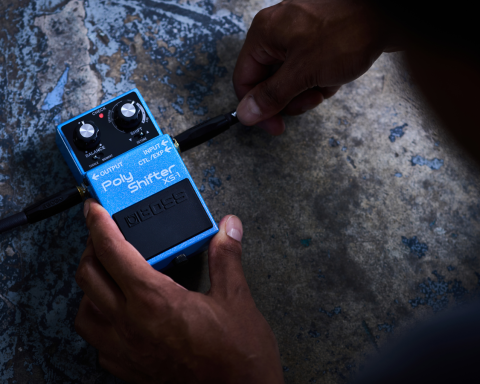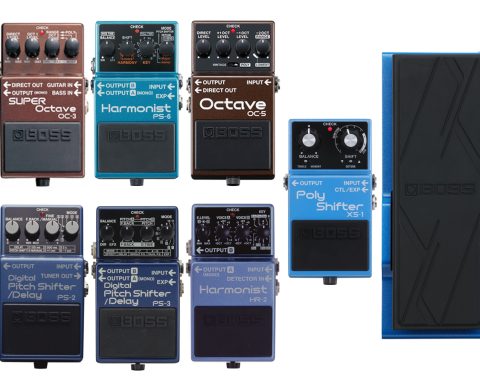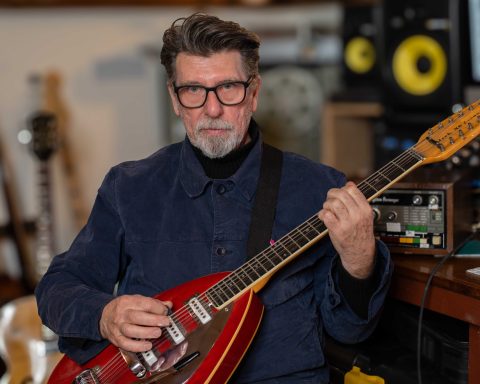There’s something undeniably captivating about the sound of a rotary speaker—fluid, dimensional, and deeply expressive. It’s a tone that continues to inspire players and producers alike. With the new RT-2 Rotary Ensemble, BOSS distils decades of sonic history into a format that’s finally compact enough for any board. In this article, we trace the roots of the rotary effect, look at how BOSS refined the formula over time, and spotlight some key artists who’ve harnessed its unmistakable swirl in powerful and creative ways.
Movement and Depth
New for 2025, BOSS brings the unmistakable sound of the rotary speaker cabinet to its iconic compact pedal format for the very first time with the RT-2 Rotary Ensemble. It’s a highly anticipated moment that’s been a long time coming.
This evocative modulation effect—instantly recognizable and endlessly expressive—has played a starring role in guitar tones since the 1960s, spanning everything from blues and prog to psychedelia, soul, and gospel. But the original rotary speaker units, famously heavy and notoriously expensive, have always been impractical for most guitarists to cart around.
Despite that, the rotary sound never faded from the collective imagination. In fact, pedal makers have spent decades trying to bottle its elusive character in stompbox form—with mixed results. The RT-2 changes that.
Drawing on cutting-edge DSP and an intensive study of the revered Leslie 122 cabinet, BOSS has crafted its most faithful recreation to date, capturing the rich spatial movement, harmonic depth, and organic feel that define the real deal.
Add extensive control features—including the ability to tweak parameters on the fly—and the RT-2 becomes more than just a tribute. It’s a fully featured tool for today’s music-makers, offering the character of a rotary rig in a convenient, pedalboard-friendly format ready for the modern stage and studio.
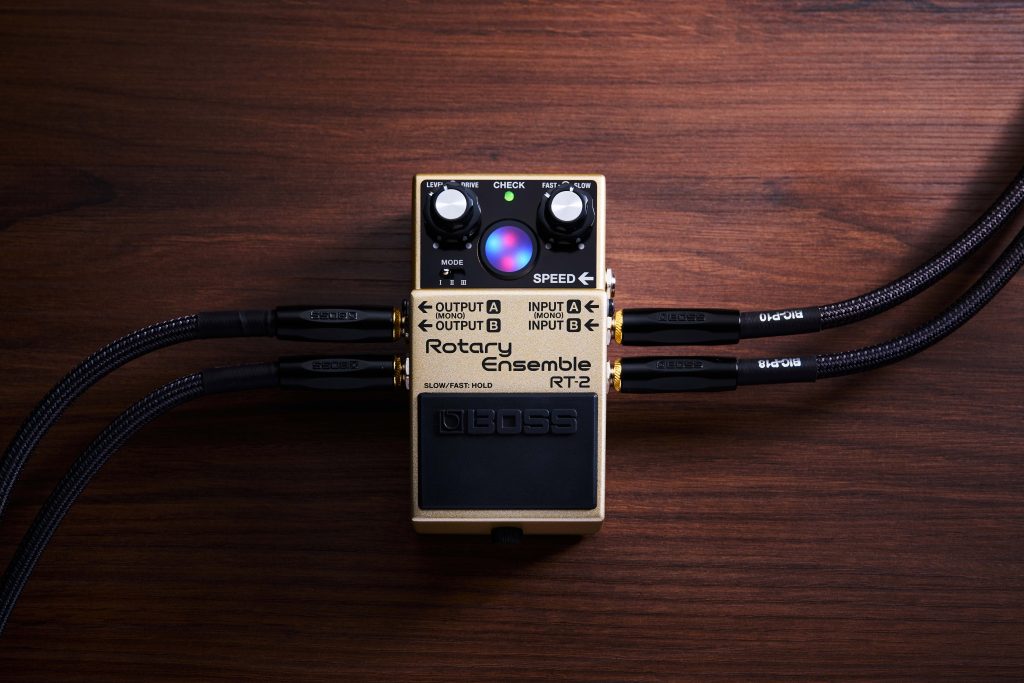
"Drawing on cutting-edge DSP and an intensive study of the revered Leslie 122 cabinet, BOSS has crafted its most faithful recreation to date."
What Is Rotary?
Rotary is a form of modulation. Yet it’s unlike the electronic-based effects guitarists typically reach for—things like chorus, phaser, vibrato, flanger, or tremolo. Those effects are born from analog circuitry alone. Rotary, by contrast, manifests in the air, generated by the physical movement of sound from specialized speaker cabinets like the classic Leslie model 122.
In a rotary speaker cabinet, part of the system physically rotates—typically a horn, drum, or baffle—causing the sound to move through space in a constantly shifting pattern. As the component turns, it creates subtle variations in pitch and volume. The result is a tone that feels alive and in motion: spatial, dynamic, and rich with a sense of depth and movement that’s difficult to replicate through conventional effects.
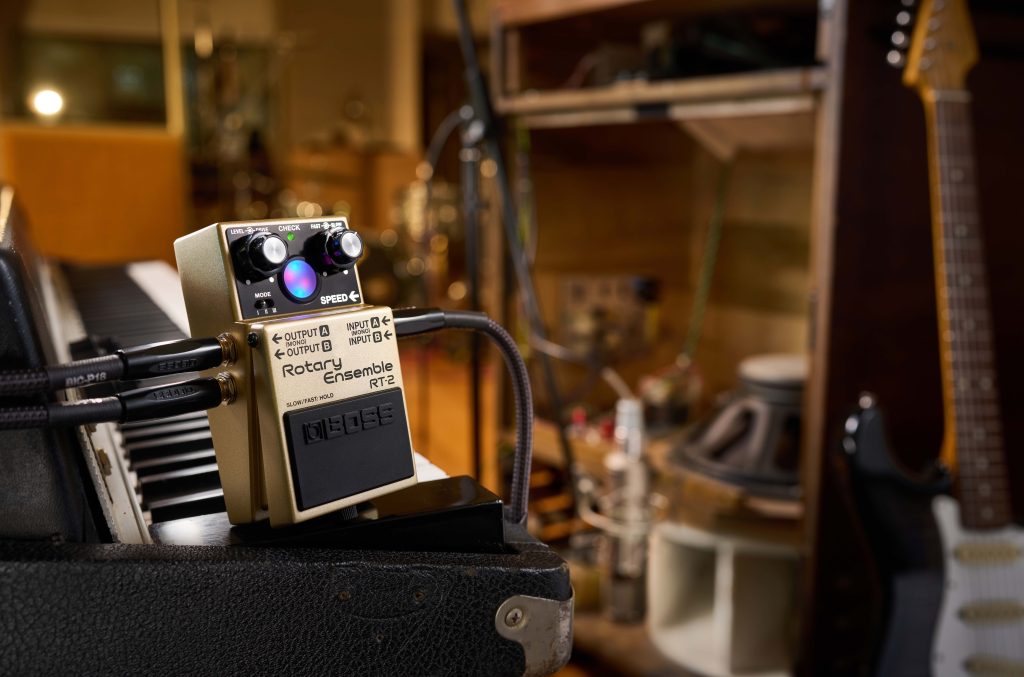
"What’s actually happening is something called the Doppler effect."
What’s actually happening is something called the Doppler effect. The same physical principle makes a passing emergency vehicle’s siren seem to change pitch as it approaches and recedes. In the case of a rotary speaker, that movement translates into subtle pitch modulation—not as dramatic as a pitch shifter, but enough to lend a sense of shimmering depth.
At the same time, amplitude subtly fluctuates, similar to tremolo. This unique blend of pitch and volume oscillation gives rotary its distinctive, almost vocal-like quality—a lush whirl of sound that feels alive in the room.
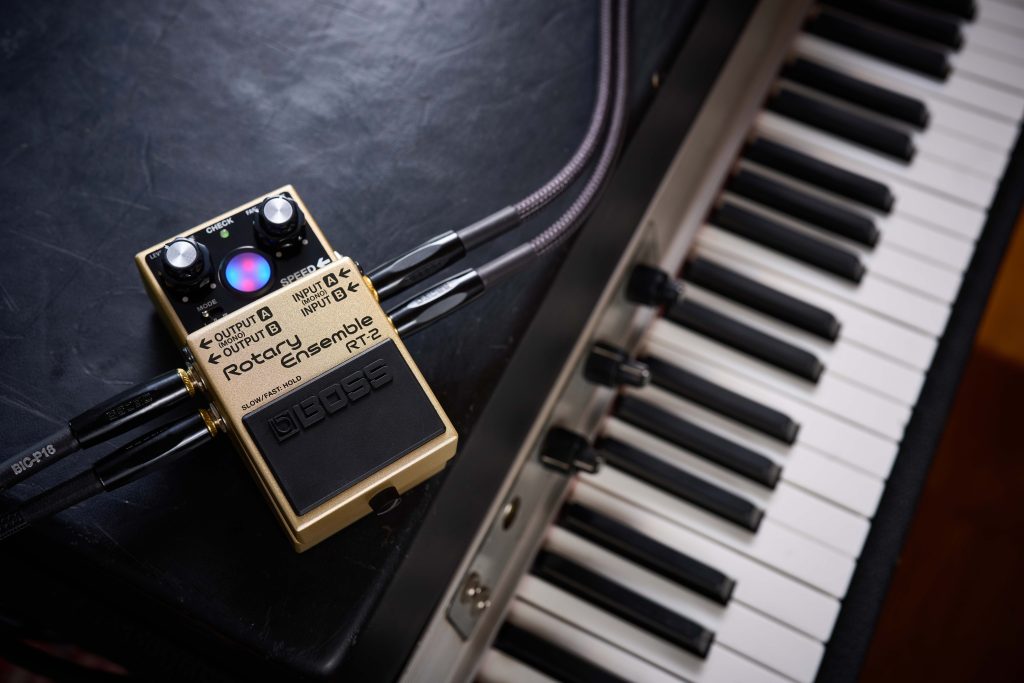
"This unique blend of pitch and volume oscillation gives rotary its distinctive, almost vocal-like quality."
The Origin of Rotary Speakers
The story of the rotary speaker begins in the late 1930s with Donald Leslie (1911-2004), an American engineer who, after bringing home a Hammond organ, found its sound lacking the dynamic, swirling depth he’d heard from pipe organs in churches and movie theaters.
Drawing on his mechanical and electrical expertise, Leslie created a speaker system that could replicate that rich, moving sound. By 1940, he had developed a rotary speaker prototype that used physical movement to produce natural modulation through the Doppler effect, where sound waves shift in pitch and volume as they move relative to the listener.
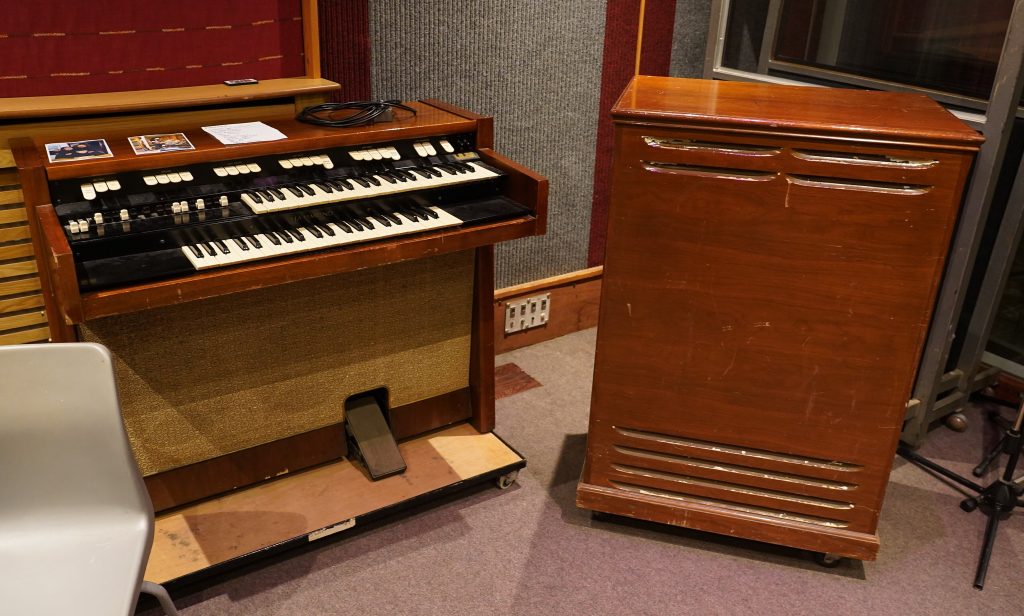
Leslie pitched his invention to the organ’s creator, Laurens Hammond (1895-1973), hoping to bundle the speaker with the instrument. Hammond, however, was unimpressed and dismissed it as an impractical novelty.
Undeterred, Leslie went on to market the speakers throughout the ’40s, settling on his name as a brand by the end of the decade. Before long, Leslie speakers became an essential companion for organists as the rotary effect’s popularity soared.
"The story of the rotary speaker begins in the late 1930s with Donald Leslie (1911-2004)."
The Leslie 122
The Leslie 122 is the rotary speaker model that set the gold standard. It uses two spinning elements to create its legendary three-dimensional sound: a compression driver fitted to a horn rotor handles the high frequencies, while a 15-inch speaker delivers the lows.
Rather than rotate the large speaker, it’s mounted above a rotating drum with an angled baffle that throws the sound in a wide 360-degree arc. A simple two-way crossover splits the signal between the horn and drum rotors, letting each frequency band move independently in space.
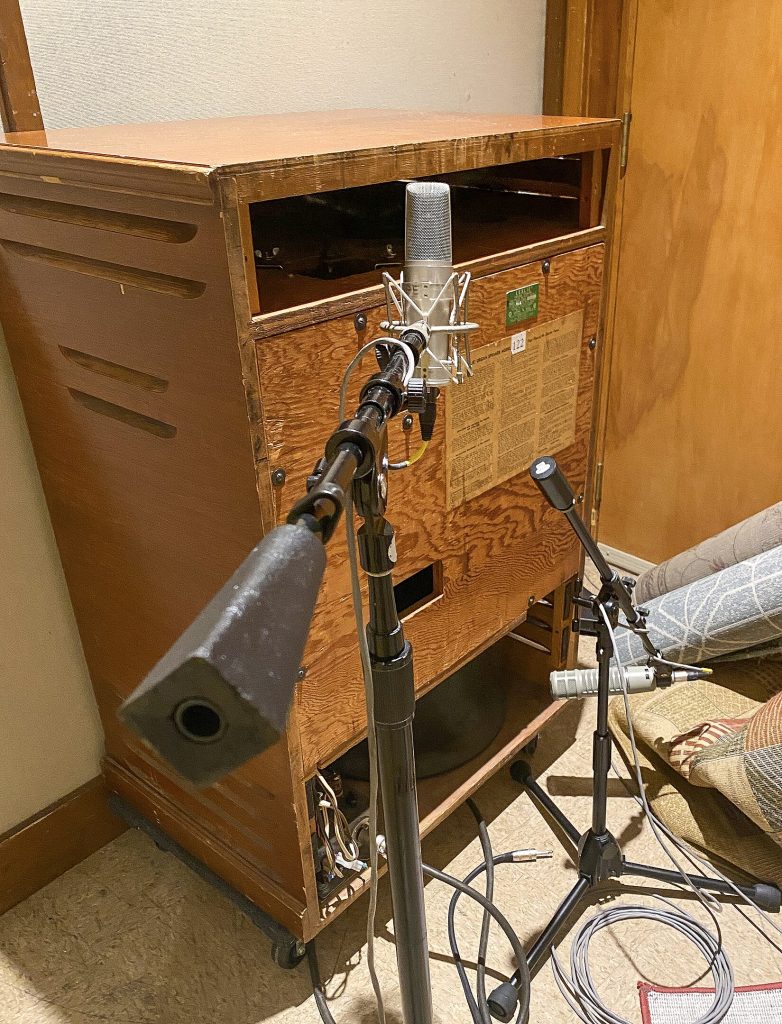
The system runs at two speeds—one named Chorale for slow, dreamy modulation, and another called Tremolo for a faster, more animated effect.
It’s this dynamic response and sense of motion that BOSS captured so convincingly in 2005 with the RT-20 Rotary Ensemble—and now pushes even further with the RT-2, delivering the full Leslie experience in a compact, stage-ready form.
The Magic of the RT-2 Rotary Ensemble
The RT-2 Rotary Ensemble recreates the elusive magic of a Leslie speaker with remarkable precision. It uses cutting-edge DSP with a detailed analysis of the original Leslie 122 to emulate the complex sounds of its horn and drum rotors.
This tone-shaping toolkit boasts three distinctive modes, each offering a unique perspective on the rotary effect. There’s a broad tonal palette to explore. Using these modes, musicians and producers can experiment, mix textures, and uncover signature sounds that respond beautifully to different playing styles and pedal combinations.
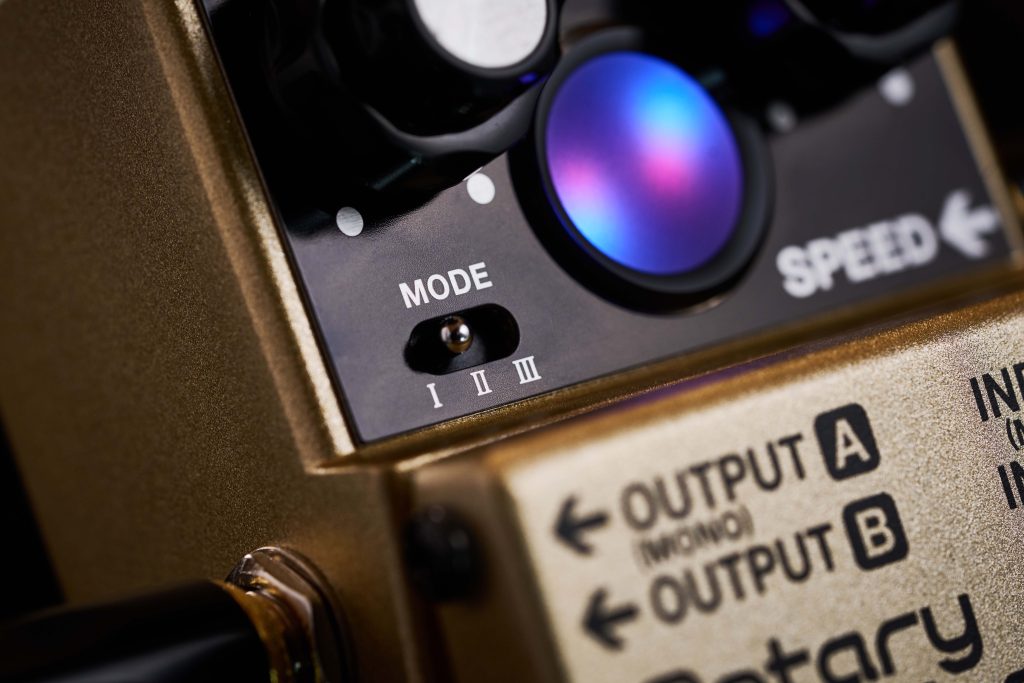
"Mode I delivers the purest rotary experience, faithfully recreating the warm, nuanced tone of the revered Leslie 122."
Mode I is where it all begins. This setting delivers the purest rotary experience, faithfully recreating the warm, nuanced tone of the revered Leslie 122. Its slightly narrower frequency range evokes an intimate, organic sound that’s perfect for shimmering arpeggios, subtle chord work, or atmospheric passages.
There’s a richness here that feels instantly familiar, and its versatility makes it ideal for a wide variety of instruments and musical genres. It’s the essential rotary voice—authentic and elegant.
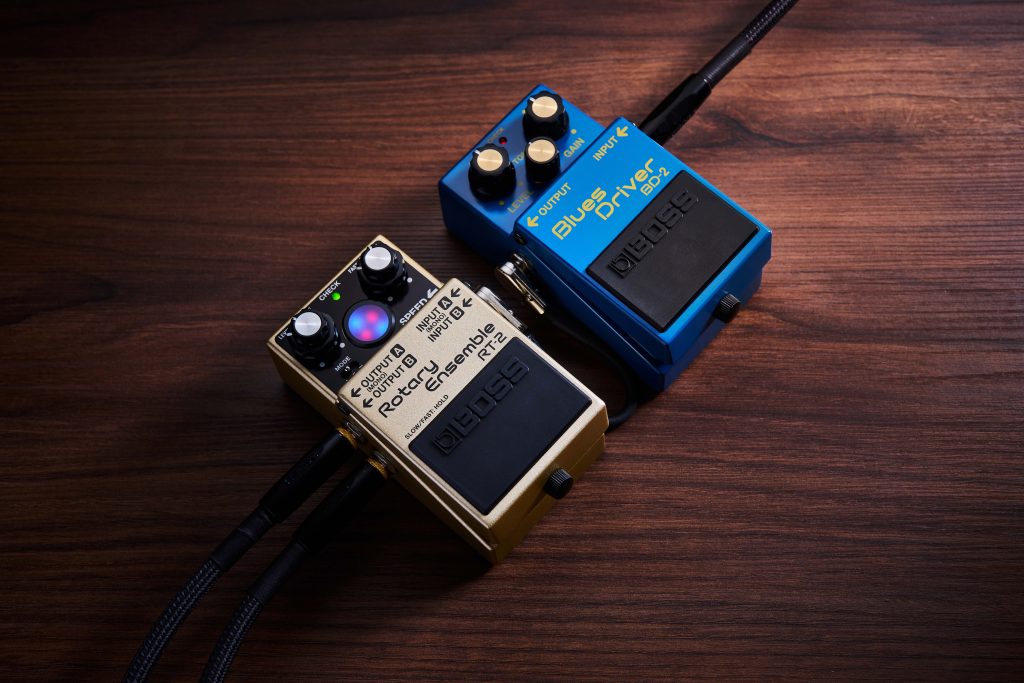
"Mode II takes that foundational character, widens the frequency range, and opens up the response, allowing for a more expansive feel."
Mode II takes that foundational character and stretches its sonic wings. Here, the RT-2 widens the frequency range and opens up the response, allowing for a more expansive feel. The modulation is more pronounced, and there’s a spaciousness that pairs beautifully with gain pedals.
Whether layering textures or adding dimension to a lead line, Mode II brings added depth without losing the organic character of the original Leslie tone. It’s a subtle yet powerful shift—perfect for players who want their sound to bloom in the mix.
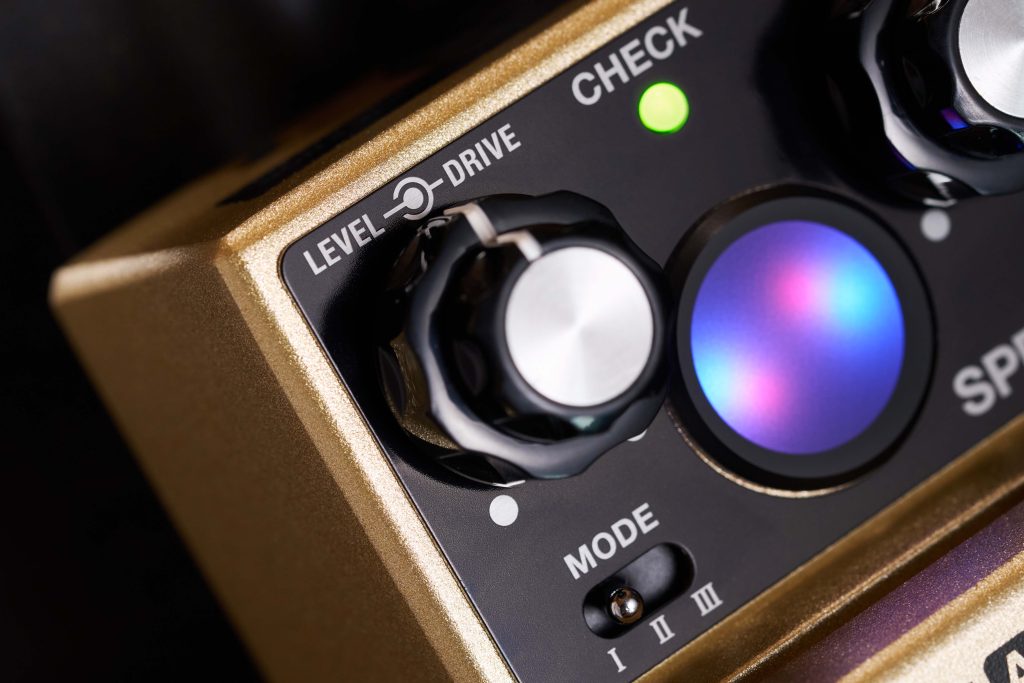
"Mode III introduces a more aggressive spin with increased drive, for those seeking sharper articulation and stronger presence."
Mode III is where things really heat up. This mode introduces a more aggressive spin with increased drive, making it a go-to for those seeking sharper articulation and stronger presence. By extending the gain range and adding bite, Mode III helps your tone cut through even the densest arrangements.
It’s a smart evolution of the rotary concept, especially for players who enjoy blending modern pedalboard setups with vintage-inspired textures. Bold and commanding, this mode was made to stand out.
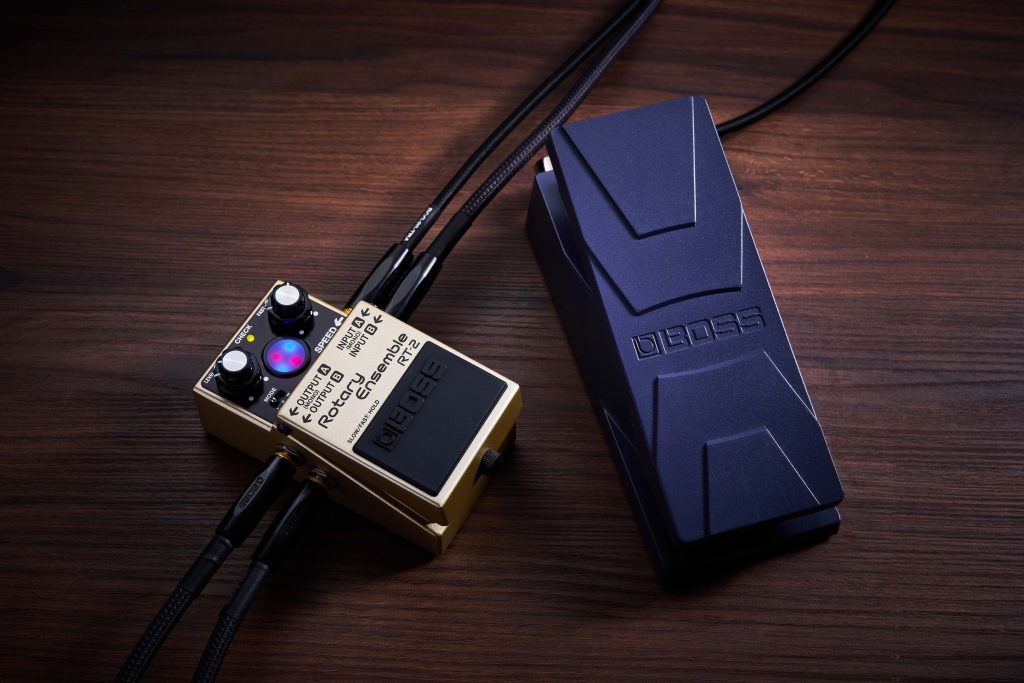
"A dedicated Balance control lets you fine-tune the relative levels of each rotor."
A dedicated Balance control lets you fine-tune the relative levels of each rotor, and if you connect an optional expression pedal like the BOSS EV-30, you can dynamically adjust Balance in real time—ideal for performance-led sound shaping.
That same expression pedal can also be assigned to control rotor speed, plus Drive or Level parameters, giving players hands-free access to vital settings.
Like the Leslie 122’s Chorale and Tremolo settings, you can set independent Slow and Fast speeds to suit your musical needs using dual-axis knobs, and switch between them using a long-press on the RT-2’s onboard footswitch.
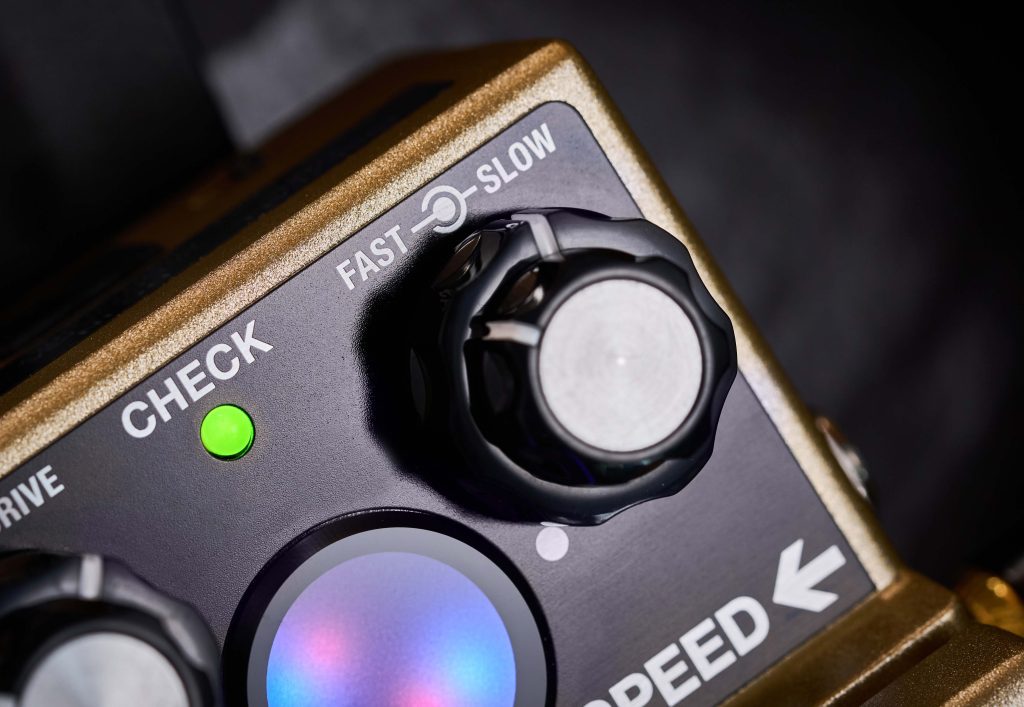
"Like the Leslie 122’s Chorale and Tremolo settings, you can set independent Slow and Fast speeds to suit your musical needs."
For even greater control, you can connect up to two external footswitches, such as the BOSS FS-5U, FS-6, or FS-7. With a dual footswitch setup (FS-6 and FS-7), you can toggle Slow and Fast settings and access the Brake function, which temporarily stops the virtual rotors from spinning, just like the real thing.
You can even choose whether speed transition happens gradually or more quickly, thanks to a Slow/Fast selector switch on the rear panel labelled Rise/Fall Time.
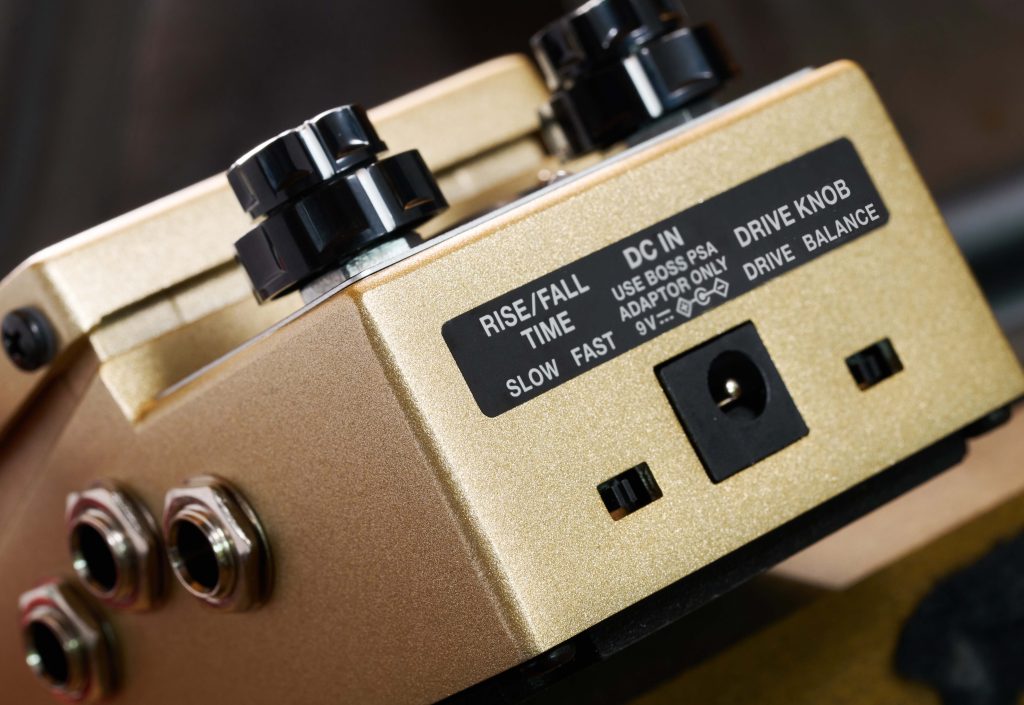
It’s hard to overstate the immersive quality of a high-quality rotary speaker. It doesn’t simply enhance your tone—it transforms it, imbuing your sound with spatial color and a sense of shifting space. The RT-2 captures that authentic feeling in a pedalboard-friendly box, ready to bring a touch of ageless, 3D modulation to any rig.
"The RT-2 captures that authentic feeling in a pedalboard-friendly box, ready to bring a touch of ageless, 3D modulation to any rig."
Twin Pedal Series: The RT-20 Rotary Ensemble
Before the RT-2, there was the RT-20—a landmark moment in the evolution of BOSS modulation. Launched in 2005, this entry in the Twin Pedal Series brought the swirling sound of a rotary speaker into pedalboard reach for the first time with real conviction.
At its heart was BOSS’s proprietary COSM (Composite Object Sound Modeling) technology, which allowed the RT-20 to capture the complex, organic motion of a Leslie 122 with remarkable accuracy—whether in mono or rich stereo.
But the RT-20 was never just a basic rotary emulation. It offered a surprising level of control and depth. These thoughtful touches gave players the tools to tailor the effect to suit a wide range of tones and playing styles—whether chasing vintage authenticity or pushing into more experimental territory.
The RT-20 packed four distinct modes, each offering a unique spin on the rotary sound. Mode I delivered a faithful take on the Leslie 122 with natural overdrive—versatile and well-balanced for a wide range of styles. Mode II retained the 122 core but added an “on-mic” character, enhancing the tremolo-like throb for a more pronounced pulse.
Mode III pushed things further, blending the 122 voicing with the aggressive distortion of a Marshall model 1959 sound, creating a bold, saturated tone. Mode IV combined a Uni-Vibe-style modulation with the same Marshall Super Lead-like drive, channeling vintage psychedelic rock with a swirling intensity.
"The RT-20 was never just a basic rotary emulation. It offered a surprising level of control and depth."
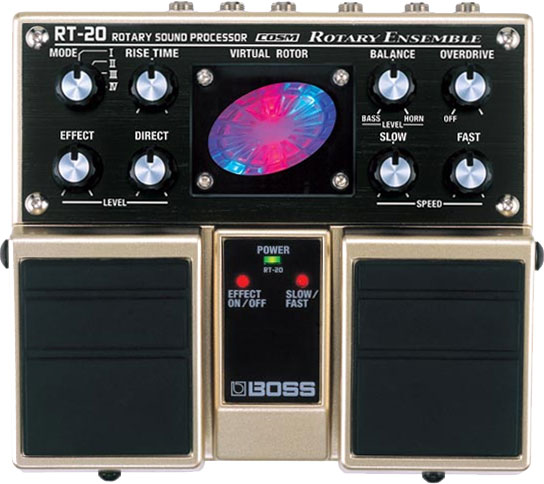
Used by longtime Leslie-loving guitar legends like Peter Frampton, the RT-20 found favor with countless notable six-string slingers. From old-school rockers such as Bruce Springsteen and Steven Van Zandt to metalheads Richie Faulkner of Judas Priest and Bill Kelliher of Mastodon, the RT-20 brought high-quality rotary sound to the pedalboard.
Although production ceased in 2019, the RT-20’s influence is deeply embedded in the design of its successor, the RT-2. While the newer model benefits from cutting-edge DSP and deeper analysis of the original Leslie 122 design, BOSS engineers were careful not to lose the musical essence that made the RT-20 so revered.
Much of the RT-2’s tonal DNA can be traced directly back to this earlier unit—a fitting tribute to one of the most accomplished rotary pedals ever made.
"Although production ceased in 2019, the RT-20’s influence is deeply embedded in the design of its successor, the RT-2."
Rotary Sounds in Popular Music
By the mid-1960s, the rotary sound had begun to escape the confines of the organ world and find its way into the hands of guitarists, vocalists, and forward-thinking producers.
Studio pioneers quickly recognized its potential—using its swirling movement and shifting textures to bring a sense of depth, atmosphere, and otherworldliness to recordings.
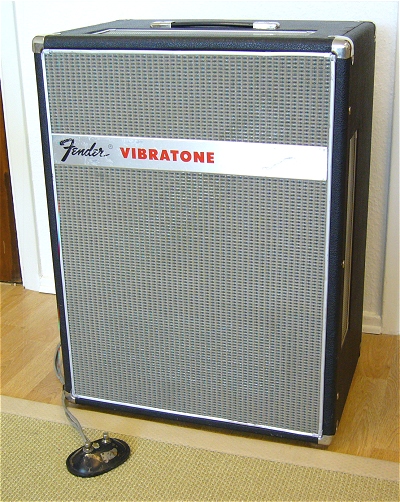
From The Beatles in the UK to The Beach Boys in California, the effect became a signature flourish on some of the era’s most groundbreaking and influential records—sonic milestones that still echo through modern music.
Here are a half a dozen landmark tracks where the unmistakable rotary sound left its mark on popular music. These formative recordings showcase just how powerfully the rotary effect helped shape modern music.
“Hoodoo Man Blues” from Hoodoo Man Blues by Junior Blake (1965)
Hoodoo Man Blues, the 1965 debut from Junior Wells and his Chicago Blues Band with Buddy Guy, isn’t just a cornerstone of blues—it’s also one of the earliest recorded examples of a guitar running through a Leslie speaker.
Legend has it that midway through the session, electric blues guitar veteran Guy experienced severe technical problems with his amp. Thinking on his feet, he plugged straight into the Leslie cab of a Hammond B3 organ parked in the studio.
The result? That unmistakable swirling tone we’ve come to associate with guitar-fed rotary effects.
“Pet Sounds” from Pet Sounds by The Beach Boys (1966)
Brian Wilson—the driving creative force behind The Beach Boys—was already reshaping pop music when he began recording Pet Sounds in 1965. Moving far beyond the band’s early surf anthems, Wilson embraced complex arrangements, rich harmonies, and radical studio experimentation.
On the album’s title track, he deployed the Leslie speaker to remarkable effect, sending electric guitar through the spinning cabinet to create that iconic swirling, immersive texture.
Though he’d experimented with the effect before, its prominent role on Pet Sounds marked a turning point—transforming the studio itself into a vital part of the songwriting process.
“Tomorrow Never Knows” from Revolver by The Beatles (1966)
On “Tomorrow Never Knows,” the closing track of Revolver, The Beatles tore up the rulebook. From the second verse onwards, John Lennon’s vocal takes on a disembodied presence, achieved by routing his voice through a Leslie speaker.
Known mainly for adding movement to organ tones, the Leslie’s swirling modulation gave Lennon’s vocal an unsettling, hypnotic quality that perfectly matched the song’s otherworldly backdrop.
Similar to their contemporaries, The Beach Boys, it was a pivotal moment—not just in The Beatles’ evolution but in the history of recorded sound—marking the studio’s transition from documentary tool to creative instrument.
“Planet Caravan” from Paranoid by Black Sabbath (1970)
Tucked among the heavy metal firepower of Paranoid—alongside riff-driven juggernauts like “War Pigs,” “Paranoid,” and “Iron Man”—“Planet Caravan” feels like it drifted in from another universe.
For this psychedelic detour, Ozzy Osbourne’s vocals were fed through a Leslie speaker, giving his voice a ghostly, swirling presence that floats through the mix like cosmic vapor. The effect adds to the song’s meditative, space-bound atmosphere—otherworldly in both tone and intent.
Fittingly, the track was used in 2020 as a wake-up call for NASA astronauts Robert Behnken and Douglas Hurley aboard a SpaceX mission to the International Space Station—a surreal cosmic journey that echoed Sabbath’s own sonic voyage fifty years earlier.
“Couldn’t Stand the Weather” from Couldn’t Stand the Weather by Stevie Ray Vaughan and Double Trouble (1984)
After CBS took ownership of both Fender and Leslie in the mid-1960s, it wasn’t long before a crossover product emerged. In 1967, Fender began producing the Vibratone—a guitar-friendly rotary speaker cabinet based on the Leslie model 16.
The Vibratone housed a 10-inch Jensen speaker positioned behind a rotating 15-inch styrofoam baffle, spun by a motorized rotor. It offered two speeds, producing either a lush, chorus-like swirl or a tighter vibrato pulse.
Stevie Ray Vaughan later made the Vibratone his own, folding it into his rig during the recording of Couldn’t Stand the Weather. On the album’s title track, the effect is used with real finesse—never dominating the mix, but adding a deep, swirling dimension that subtly enhances his already unmistakable tone.
“Black Hole Sun” from Superunknown by Soundgarden (1994)
Soundgarden’s “Black Hole Sun”—lifted from 1994’s Superunknown—was recorded in 1993 and owes much of its haunting character to a Leslie model 16 rotary speaker.
Virtually identical in design to the Fender Vibratone, the cab was driven by a Marshall head and used to process the guitar’s upper-register arpeggios in the verses.
The result is that unmistakable warbling texture: slow, hypnotic, and slightly off-kilter, like a heat haze through a bad dream. Set against the wide-open chords and saturated heaviness of the chorus, the Leslie-treated guitar gives the track its eerie undercurrent, echoing the surreal weight of Chris Cornell’s lyrics.

